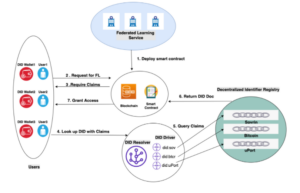With data on a blockchain, fellow organisations can work together to improve intelligent models while protecting patient privacy
A blockchain is an immutable transaction ledger maintained within a distributed network of peer nodes. These nodes each maintain a copy of the ledger by applying transactions that have been validated by a consensus protocol, grouped into blocks that include a hash that binds each block to the preceding block. However, many enterprise use cases require performance characteristics that permissionless blockchain technologies are unable to deliver and comply with existing regulations. For the enterprise setting, aspects such as identifiability, permission, high transaction throughput performance, low latency and confidentiality must be met. Hyperledger Fabric is an open-source enterprise-designed permissioned distributed ledger technology platform that offers edging capabilities over classical distributed ledger platforms. Fabric has a permissioned scalable modular architecture, eliminates any non-determinism, thus enabling standard programming languages in smart contracts, and introduces a private data feature in the form of channels. All in all, Hyperledger Fabric is a highly scalable system for permissioned blockchains that support a wide range of applications.
One of the use cases that ESR3 has given to this system is in the sense of federated learning, as published in “DID-eFed: Facilitating Federated Learning as a Service with Decentralized Identities” [1]. Federated
learning emerges as a functional solution that can help build high-performance models shared among multiple parties while complying with user privacy and data confidentiality requirements. They introduce flexible and credible decentralized access management using the techniques mentioned above. Further developing the idea of federated learning, we started a research project to implement a multi-center database for training a deep learning algorithm for non-muscle invasive bladder cancer diagnosis. With data on a blockchain, fellow organisations can work together to improve intelligent models while protecting patient privacy. Models can be trained locally and then be merged in the cloud. Currently, this is a work in progress, but we cannot wait to show the results of this collaboration.
[1] Jiahui Geng, Neel Kanwal, Martin Gilje Gilje Jaatun and Chunming Rong. “DID-eFed: Facilitating Federated Learning as a Service with Decentralized Identities.” Evaluation and Assessment in Software Engineering (2021): 329-335
Federated learning framework from [1]
Saul Fuster Navarro – ESR5.


